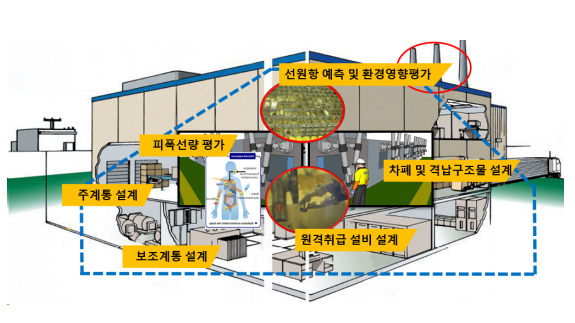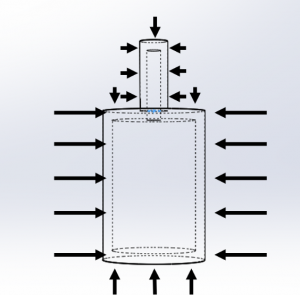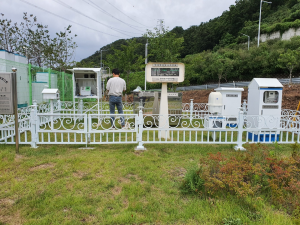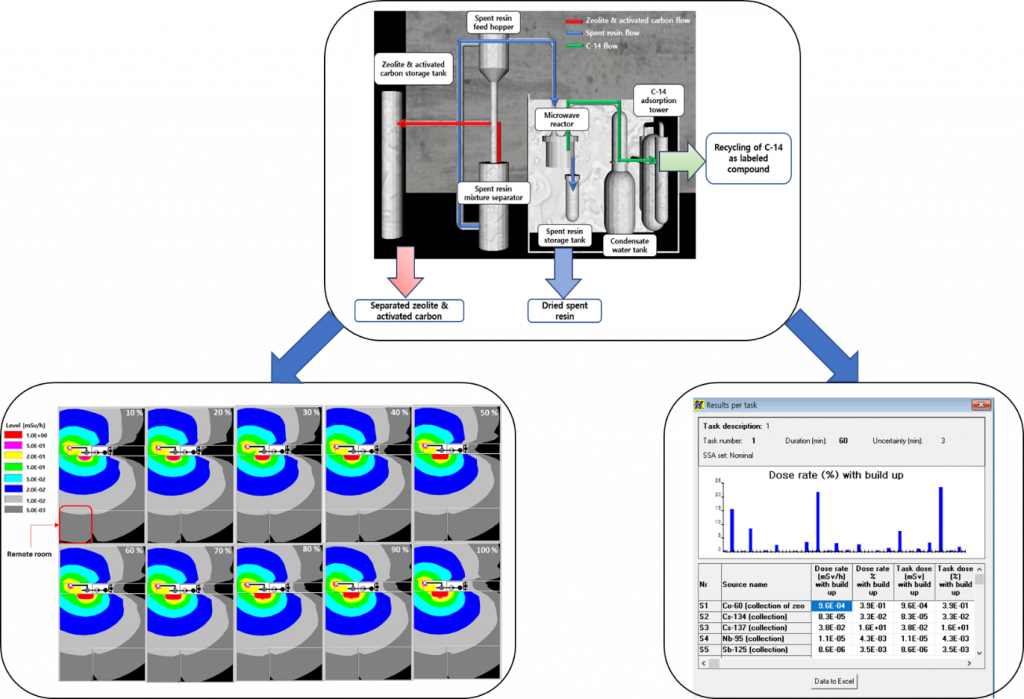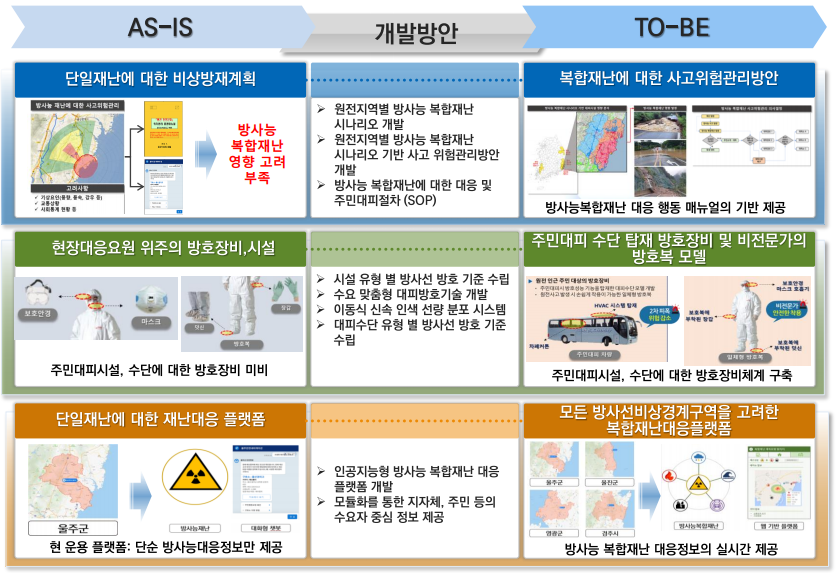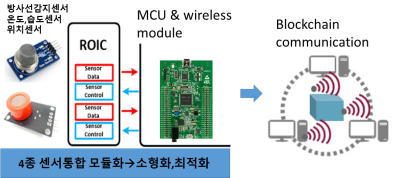Ongoing research
The RAMDA lab conducts general research on radiation, including NPP decommissioning, environmental radiation investigation, radiation protection, and radiation measurement.
Nuclear decommissioning
- Development of Portable Detection System for Air-borne Contamination by Alpha and Beta Radioactive Source
In this research project, the measurement technology for alpha-beta radioactive materials in the air, which is difficult to measure, and its application to provide continuous monitoring in real-time in nuclear-related facilities.
The development system applies a high-efficiency silicon semiconductor planar detector to selectively measure alpha-beta radioactive materials, and also applies a radionuclide classification electronic circuit for background removal due to radon and natural radiation.
It is developed so that it can be operated in conjunction with the existing radiation monitoring system operating in nuclear-related facilities, and a wireless transceiver is installed to implement the function so that it can be monitored at all times in the control room and at the desired place.
* Participating researchers: Sihyeong Sung, Minji Kim
* Q&A: shlove912@unist.ac.kr
- Safety Evaluation and Design Technology Development of Core Demonstration Facilities for Nuclear Power Plant Decommissioning
The safety evaluation and development of design technologies for core demonstration facilities for nuclear power plant decommissioning are urgently required following the permanent shutdown of Kori-1 and the initiation of immediate dismantling. The radioactive metal decommissioning waste handled by core demonstration facilities contains nuclides generated by uncertain impurities, resulting in high uncertainty in the source of radiation. Safety assessments are being made for worker exposure doses and suspended radiation sources at core demonstration facilities where the process of handling waste with high uncertainty is carried out.
* Participating researchers: Kijoon Kang, Sia Hwang, Seunghun shin, kyunghun shin
* Q&A: roffl1234@unist.ac.kr
- Development of a Container for Transporting and Storing Very-low Level Liquid Waste from Nuclear Power Plant Decommissioning
In order to secure the safety of the temporary storage and transport of very-low level liquid waste generated at the nuclear power plant decommissioning site, the concept of a container for transporting very-low level liquid waste that satisfies the technical standards and requirements set out in the regulations on packaging and transport of radioactive materials was established. The goal is to develop and commercialize radioactive waste transport containers by securing transport container design, radiation shielding, and structural safety in accordance with IP-2 type technical standards.
* Participating researchers: Seunghun Shin, Woonyun Choi, Seungbin Yoon
* Q&A: rjqnr0124@unist.ac.kr
- Development of In-situ Monitoring Techniques for Ground Water in D&D Site
In order to develop groundwater radioactive contamination monitoring technology for site environment restoration after dismantling nuclear facilities, we will develop core technology for monitoring tritium radiation to improve sensitivity based on technology to remove gross beta, gamma dose rate, and self-absorption effects in the water. This monitoring system is aimed at real-time measurements in the field.
∙ Used for site leakage monitoring of pollutants during decontamination and decommissioning processes
∙ Used for environmental restoration work of decontamination and dismantling sites, for monitoring the radioactivity in the groundwater of the site
∙ Used to monitor radioactive contamination in the water around nuclear facilities
∙ Used to monitor beta and gamma radiation concentrations around seawater desalination facilities
∙ Inducing advancement of beta radiation in situ measurement technology in water or soil
∙ Lay the foundation for on-site real-time measurement technology for ultra-low energy beta rays such as tritium
∙ Lay the groundwork for improving domestic technology in the field of radiation monitoring and restoration of nuclear power plant decommissioning sites
* Participating researchers: Woonyun Choi, Hyeonmin Lee, Seungbin Yoon
* Q&A: chldnsus95@unist.ac.kr
- Evaluation of Degradation Performance of Concrete Using NPP Structure to be Decommissioned
The goal of this study is to establish an empirical database of concrete materials using the actual structures of nuclear power plants to be dismantled and to develop and standardize degradation performance evaluation models and standards based on this. In order to build an empirical database of concrete materials using the actual structure of the nuclear power plant to be dismantled, first, understand the concrete structure of the target nuclear power plant, evaluate what factors cause deterioration by part, and then select a sampling location suitable for the evaluation of the deterioration mechanism. After selecting and collecting samples, the effect of deterioration should be evaluated by applying a test method suitable for identifying the deterioration mechanism at the sampling location.
The RAMDA laboratory evaluates and verifies the radiation dose of concrete structures near the pressure vessel. In the case of neutrons, which have the greatest influence on the mechanical properties of concrete, the neutron flux and neutron spectrum vary greatly depending on the depth inside the biological shield. The radiation flux of the concrete structure near the reactor pressure vessel is calculated using various radiation transport codes such as DOOR3, ETRAN, EGS, and MCNP. In this study, the neutron flux and gamma flux are evaluated using the MCNP code. The most important thing in evaluating the deterioration performance of the concrete near the reactor pressure vessel is the radiation dose actually received by the concrete structure near the reactor pressure vessel. By using the concentration, half-life, and neutron absorption cross-sectional area of each major radioactive nuclide, the nuclear power plant operating history, etc. are used to evaluate the radiation dose actually received by the concrete structure near the reactor pressure vessel and to secure data on the impurities in the concrete structure.
* Participating researchers: Woonyun Choi, Hyeonmin Lee, Hara Kang
* Q&A: chldnsus95@unist.ac.kr
- Development of Dismantling Technology for the Volume Reduction of Radioactively Contaminated Tanks
The purpose of the task is to develop a process for recovering the sludge accumulated in the tank for the treatment of radioactively contaminated tanks of decommissioned nuclear power plants. Recovered sludge is reduced to 1/10 of that of using a filter through hot isostatic pressing technology, and an entire system that can satisfy disposal safety and disposal acceptability is developed. In addition, by demonstrating the performance of the tank dismantling process for waste tanks similar to those used in nuclear power plants, a system for decontamination of fixed contaminants inside metal tanks, tank recycling management, and complex tank treatment systems should be developed.
* Participating researchers: Kijoon Kang, Sia Hwang, Jaeho Lee
* Q&A: roffl1234@unist.ac.kr
- A Study on Regulatory Policy on Improvement of D&D Regulatory systems
As the number of nuclear power plants to be decommissioned is going to increased, the project is being carried out to review conventional regulations and to improve regulations involving decommissioning regulations for the permanent shutdown and decommissioning of the nuclear facility.
Contents of R&D –
- Review the policy direction for improvements of the decommissioning regulation of the Nuclear Safety Act, which reflects the nuclear facility decommissioning precedents from overseas under construction/operation or dismantled.
- Deduct improvement points for nuclear facility decommissioning in terms of nuclear safety by investigating conventional regulations and cases.
* Participating researchers: Hara Kang, Woonyun Choi, Jaehoon Byun, Kyunghun Shin
* Q&A: mqovopm@unist.ac.kr
- Nuclear Decommissioning Industrial Ecosystem Revitalization Support Project
1. Development of materials for decommissioning NPP
- Writing of nuclear power plant decommissioning textbooks through expert advice in each field of decommissioning
2. Nuclear power plant decommissioning workshop/forum
- Hosting an event to promote the decommissioning of nuclear power plants
- Energy Convergence Forum (4 divisions: nuclear power decommissioning, micro-reactor, plasma industry, nuclear fusion research institute, etc.)
3. Discovery and planning of technological development tasks through the establishment of domestic/foreign cooperative networks for nuclear power plant decommissioning
- Supporting discovery of joint R&D projects in connection with universities, research institutes, and companies in Ulsan
* Participating researchers: Seungbin Yoon, Woonyun Choi
* Q&A: sbyoon@unist.ac.kr
Environmental radiation investigation
- SAEUL Nuclear Power Plant Environmental Radiation Investigation
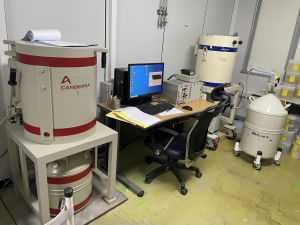
Environmental radiation survey in the vicinity of a nuclear power plant investigates the presence of radionuclides due to the operation of a nuclear power plant in the surrounding environment and evaluates the actual and potential exposure doses that can be given to the surrounding residents to provide public awareness of the use of nuclear power.
In other words, it is confirmed that the emission from nuclear power plants is sufficiently below the regulation value set by the nuclear power laws of Korea, and at the same time, it is also checked whether the health and safety of local residents.
In order to investigate the environmental radioactivity around the Saeul Nuclear Power Plant, radioactivity measurements of gamma, beta, tritium, strontium, and radiocarbon of 14 land samples and 6 marine samples are being conducted.
* Participating researchers: all members
* Q&A: shlove912@unist.ac.kr
- GYEONGJU region Environmental Radiation Investigation
In addition to collecting gamma exposure rate data that can quickly monitor changes in radiation/activity level in Gyeongju, it measures the concentration of radioactivity in 12 samples include tap water, fallout, and so on.
In addition, basic data for national radiation safety is secured by periodic monitoring of living environment samples (soil, surface water, rice and vegetables, surface plants, etc.) and investigation of radioactive concentrations in consumed foods. Environmental sample collection and pre-treatment are being carried out for beta, gamma, and tritium investigations.
* Participating researchers: all members
* Q&A: shlove912@unist.ac.kr
Radiation protection
- Development and Demonstration of a Prototype Equipment for C-14 Containing Radwastes Disposal
A 1 ton/day facility that can efficiently desorb C-14 using microwaves without generating secondary waste from the spent resin mixture generated in the heavy water reactor is being developed. Therefore, dose evaluation of the worker is essential to ensure the radiological safety of the worker. In this project, the radiation environment is modeled in 3D using the VISIPLAN 3D ALARA Planning Tool based on various scenarios (normal operation and accident scenarios of the spent resin treatment facility) to evaluate the worker’s dose. Through this study, it is expected that the worker’s radiological safety can be satisfied in terms of ALARA when the facility is operated in the future.
* Participating researchers: Jaehoon Byun, Woonyun Choi, Seungbin Yoon
* Q&A: whrkrtptkd@unist.ac.kr
- Development of Scenario and Equipment for Evacuation, Sheltering, and Protective
Development of radioactive complex disaster scenarios and accident risk management plans for each scenario; Development of protection facilities for shelters, hospitals, and houses in the event of a radioactive complex disaster, as well as protective equipment and transportation; RAMDA Lab is conducting research with the goal of developing performance indicators and prototypes of personal protective equipment and environment radiation detector for radioactive disaster.
* Participating researchers: Seunghoon Shin, Chanki Lee, Hyeonmin Lee
* Q&A: rjqnr0124@unist.ac.kr
- Development of Blockchain-based IoT Platform for the Radioactive Waste Management
It is a project to track and trace the occurrence of accidents or status changes in the process of disposing and receiving radioactive waste drum in real-time by applying the advantage of the blockchain, in which individuals cannot arbitrarily manipulate data, to radioactive waste history management. The purpose of this project is to develop a blockchain-based radioactive waste history management IoT platform that allows administrators to immediately recognize and respond to changes in monitoring data due to theft or damage to radioactive waste drums.
* Participating researchers: Kijoon Kang
* Q&A: roffl1234@unist.ac.kr

